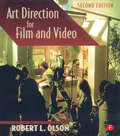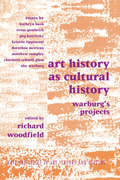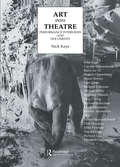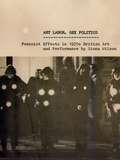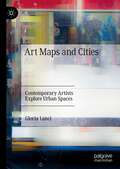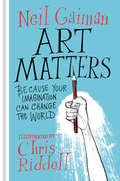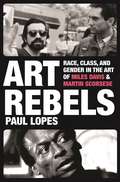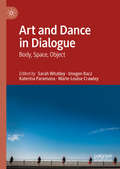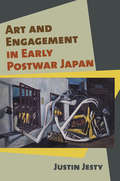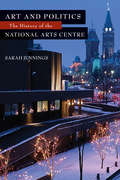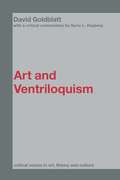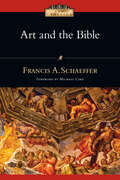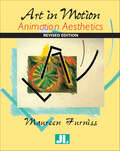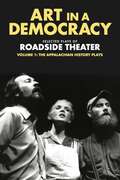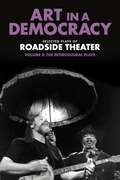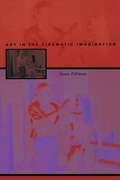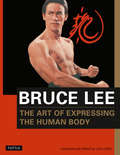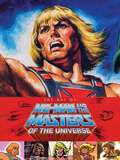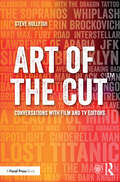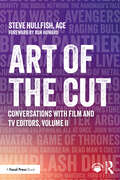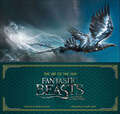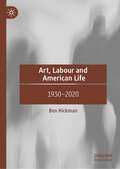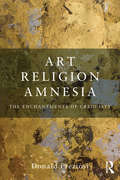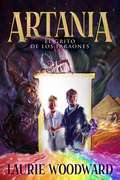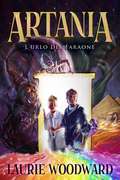- Table View
- List View
Art Direction for Film and Video
by Robert OlsonWritten by an author with over 30 years of working experience, this book takes a practical, thorough look at the duties and skills of art directors and production designers. It teaches readers how to analyze a script, develop concepts that meet the needs of a script, develop sketches and construction drawings, work with directors and producers, and operate within budget limitations. The book has been updated and expanded to include interviews with professionals at all levels in the art department. A chapter on digital effects as they relate to the work of the art director has been added to this new edition. Students, novices in the profession, and persons from other art/design fields who are interested in expanding into film and video will find this is a valuable resource. Written by an author with over 30 years of working experience, this book takes a practical, thorough look at the duties and skills of art directors and production designers. It teaches readers how to analyze a script, develop concepts that meet the needs of a script, develop sketches and construction drawings, work with directors and producers, and operate within budget limitations. The book has been updated and expanded to include interviews with professionals at all levels in the art department. A chapter on digital effects as they relate to the work of the art director has been added to this new edition. Students, novices in the profession, and persons from other art/design fields who are interested in expanding into film and video will find this is a valuable resource.
Art History as Cultural History: Warburg's Projects (Critical Voices in Art, Theory and Culture)
by Richard WoodfieldThis book focuses on Aby Warburg (1866-1929), one of the legendary figures of twentieth century cultural history. His collection, which is now housed in the Warburg Institute of the University of London bears witness to his idiosyncratic approach to a psychology of symbolism, and explores the Nachleben of classical antiquity in its manifold cultural legacy. This collection of essays offers the first translation of one of Warburg's key essays, the Gombrich lecture, described by Carlo Ginzburg as 'the richest and most penetrating interpretation of Warburg' and original essays on Warburg's astrology, his Mnemosyne project and his favourite topic of festivals. Richard Woodfield is Research Professor in the Faculty of Art and Design at the Nottingham Trent University, England. He has edited E.H Gombrich's Reflections on the History of Art (1987), Gombrich on Art and Psychology (1996), The Essential Gombrich (1996), and a volume on Riegl in the Critical Voices in Art, Theory and Culture series. He is also the General Editor of a new series of books for G+B Arts International, Aesthetics and the Arts. Edited by Richard Woodfield, Research Professor in the Faculty of Art and Design at Nottingham Trent University, UK.
Art Into Theatre: Performance Interviews and Documents (Contemporary Theatre Studies #Vol. 16.)
by Nick KayeArt Into Theatre investigates the processes of hybrid forms of performance developed between 1952 and 1994 through a series of interviews with key practitioners and over 80 pieces of documentation, many previously unpublished, of the works under discussion.Ranging from the austerity of Cage's 4'33" through the inter-species communication of Schneeman's Cat Scanand the experimental theatre work of Schechner, Foreman, and Kirby, to the recent performances of Abramovic, Forced Entertainment and the Wooster Group, Art Into Theatre offers a fascinating collection of perspectives on the destabilizing of conventional ideas of the art "object" and the theatrical "text". Nick Kaye's introductory essay to the volume offers a useful context for the reader and each interview is preceded by an informative biographical sketch.
Art Labor, Sex Politics: Feminist Effects in 1970s British Art and Performance
by Siona WilsonContrary to critics who have called it the &“undecade,&” the 1970s were a time of risky, innovative art—and nowhere more so than in Britain, where the forces of feminism and labor politics merged in a radical new aesthetic. In Art Labor, Sex Politics Siona Wilson investigates the charged relationship of sex and labor politics as it played out in the making of feminist art in 1970s Britain. Her sustained exploration of works of experimental film, installation, performance, and photography maps the intersection of feminist and leftist projects in the artistic practices of this heady period.Collective practice, grassroots activism, and iconoclastic challenges to society&’s sexual norms are all fundamental elements of this theoretically informed history. The book provides fresh assessments of key feminist figures and introduces readers to less widely known artists such as Jo Spence and controversial groups like COUM Transmissions. Wilson&’s interpretations of two of the best-known (and infamous) exhibitions of feminist art—Mary Kelly&’s Post-Partum Document and COUM Transmissions&’ Prostitution—supply a historical context that reveals these works anew. Together these analyses demonstrate that feminist attention to sexual difference, sex, and psychic formation reconfigures received categories of labor and politics.How—and how much—do sexual politics transform our approach to aesthetic debates? What effect do the tropes of sexual difference and labor have on the very conception of the political within cultural practice? These are the questions that animate Art Labor, Sex Politics as it illuminates an intense and influential decade of intellectual and artistic experimentation.
Art Maps and Cities: Contemporary Artists Explore Urban Spaces
by Gloria LanciThis book presents an original study on how contemporary artists are exploring urban spaces through mapping. Despite a long history of representations of cities in maps, and the relationships that can be envisaged between art maps and cities in the contemporary world, little research is dedicated to investigating how artists intervene in the realm of urban cartography. The research examines a century-old history of art maps and draws on academic debates challenging traditional notions of maps as scientific artefacts produced through accurate measurement and surveying. The potential of art maps to construct personal narratives, through contestation, embodiment and play, is analysed in the city context, where spaces are shaped by urban planning and design, political ideologies and socio-economic forces. Adopting an exploratory and interpretative research approach that investigates the confluence of theories originated in different domains, this book conducts the reader to discover what artistic practices can bring into a more creative, while inquisitive, understanding of cities. A series of semi-structured interviews with visual artists, enquiring how they apprehend, process and re-create urban spaces in artworks, explores cartographic process and methods in visual art practices in the twenty first century, which incorporates digital technologies and critical thinking.
Art Matters: Because Your Imagination Can Change the World (Apple FF)
by Neil Gaiman Chris RiddellA stunning and timely creative call-to-arms combining four extraordinary written pieces by Neil Gaiman illustrated with the striking four-color artwork of Chris Riddell.“The world always seems brighter when you’ve just made something that wasn’t there before.”—Neil GaimanDrawn from Gaiman’s trove of published speeches, poems, and creative manifestos, Art Matters is an embodiment of this remarkable multi-media artist’s vision—an exploration of how reading, imagining, and creating can transform the world and our lives.Art Matters bring together four of Gaiman’s most beloved writings on creativity and artistry: “Credo,” his remarkably concise and relevant manifesto on free expression, first delivered in the wake of the Charlie Hebdo shootings“Make Good Art,” his famous 2012 commencement address delivered at the Philadelphia University of the Arts“Making a Chair,” a poem about the joys of creating something, even when words won’t come“On Libraries,” an impassioned argument for libraries that illuminates their importance to our future and celebrates how they foster readers and daydreamersFeaturing original illustrations by Gaiman’s longtime illustrator, Chris Riddell, Art Matters is a stirring testament to the freedom of ideas that inspires us to make art in the face of adversity, and dares us to choose to be bold.
Art Rebels: Race, Class, and Gender in the Art of Miles Davis and Martin Scorsese
by Paul LopesHow creative freedom, race, class, and gender shaped the rebellion of two visionary artistsPostwar America experienced an unprecedented flourishing of avant-garde and independent art. Across the arts, artists rebelled against traditional conventions, embracing a commitment to creative autonomy and personal vision never before witnessed in the United States. Paul Lopes calls this the Heroic Age of American Art, and identifies two artists—Miles Davis and Martin Scorsese—as two of its leading icons.In this compelling book, Lopes tells the story of how a pair of talented and outspoken art rebels defied prevailing conventions to elevate American jazz and film to unimagined critical heights. During the Heroic Age of American Art—where creative independence and the unrelenting pressures of success were constantly at odds—Davis and Scorsese became influential figures with such modern classics as Kind of Blue and Raging Bull. Their careers also reflected the conflicting ideals of, and contentious debates concerning, avant-garde and independent art during this period. In examining their art and public stories, Lopes also shows how their rebellions as artists were intimately linked to their racial and ethnic identities and how both artists adopted hypermasculine ideologies that exposed the problematic intersection of gender with their racial and ethnic identities as iconic art rebels.Art Rebels is the essential account of a new breed of artists who left an indelible mark on American culture in the second half of the twentieth century. It is an unforgettable portrait of two iconic artists who exemplified the complex interplay of the quest for artistic autonomy and the expression of social identity during the Heroic Age of American Art.
Art and Dance in Dialogue: Body, Space, Object
by Sarah Whatley Imogen Racz Katerina Paramana Marie-Louise CrawleyThis interdisciplinary book brings together essays that consider how the body enacts social and cultural rituals in relation to objects, spaces, and the everyday, and how these are questioned, explored, and problematised through, and translated into dance, art, and performance. The chapters are written by significant artists and scholars and consider practices from various locations, including Central and Western Europe, Mexico, and the United States. The authors build on dialogues between, for example, philosophy and museum studies, and memory studies and post-humanism, and engage with a wide range of theory from phenomenology to relational aesthetics to New Materialism. Thus this book represents a unique collection that together considers the continuum between everyday and cultural life, and how rituals and memories are inscribed onto our being. It will be of interest to scholars and practitioners, students and teachers, and particularly those who are curious about the intersections between arts disciplines.
Art and Engagement in Early Postwar Japan
by Justin JestyJustin Jesty’s Art and Engagement in Early Postwar Japan reframes the history of art and its politics in Japan post-1945. This fascinating cultural history addresses our broad understanding of the immediate postwar era moving toward the Cold War and subsequent consolidations of political and cultural life. At the same time, Jesty delves into an examination of the relationship between art and politics that approaches art as a mode of intervention, but he moves beyond the idea that the artwork or artist unilaterally authors political significance to trace how creations and expressive acts may (or may not) actually engage the terms of shared meaning and value.Art and Engagement in Early Postwar Japan centers on a group of social realists on the radical left who hoped to wed their art with anti-capitalist and anti-war activism, a liberal art education movement whose focus on the child inspired innovation in documentary film, and a regional avant-garde group split between ambition and local loyalty. In each case, Jesty examines writings and artworks, together with the social movements they were a part of, to demonstrate how art—or more broadly, creative expression—became a medium for collectivity and social engagement. He reveals a shared if varied aspiration to create a culture founded in amateur-professional interaction, expanded access to the tools of public authorship, and dispersed and participatory cultural forms that intersected easily with progressive movements. Highlighting the transformational nature of the early postwar, Jesty deftly contrasts it with the relative stasis, consolidation, and homogenization of the 1960s.
Art and Politics: The History of the National Arts Centre
by Sarah JenningsShort-listed for the Ottawa Book Awards, 2010 This is the story of the creation and first four decades of one of Canada’s pre-eminent cultural organizations. While it documents the history of Canada’s National Arts Centre in Ottawa, it also tells the story of the arts in Canada from the 1960s to 2006. The story breaks down into three parts: the years of creation and early growth, fuelled by the talent and resources generated by Canada’s 1967 Centennial celebration; the turbulent middle years, marked by a dearth of funds and political disinterest; and finally the "renaissance," when the decision is made to restore and recast the organization to provide continuing benefit to the performing arts in Canada’s capital and the country at large. Written in a documentary style, moving from episode to episode, the story is enriched by the personal memories of those who participated in it, including the leading artists, managers, officials, and politicians who were involved.
Art and Ventriloquism (Critical Voices in Art, Theory and Culture)
by David GoldblattThis exciting collection of David Goldblatt's essays, available for the first time in one volume, uses the metaphor of ventriloquism to help understand a variety of art world phenomena. It examines how the vocal vacillation between ventriloquist and dummy works within the roles of artist, artwork and audience as a conveyance to the audience of the performer's intentions, emotions and beliefs through a created performative persona. Considering key works, including those of Nietzsche, Foucault, Socrates, Derrida, Cavell and Wittgenstein, Goldblatt examines how the authors use the framework of ventriloquism to construct and negate issues in art and architecture. He ponders 'self-plagiarism'; why the classic philosopher cannot speak for himself, but must voice his thoughts through fictional characters or inanimate objects and works. With a close analysis of two ventriloquist paintings by Jasper Johns and Paul Klee, a critical commentary by Garry L. Hagberg, and preface by series editor Saul Ostrow, Goldblatt's thoroughly fascinating book will be an invaluable asset to students of cultural studies, art, and philosophy.
Art and the Bible: Two Essays (IVP Classics)
by Francis A. Schaeffer"The lordship of Christ should include an interest in the arts," writes Francis Schaeffer. "A Christian should use these arts to the glory of God, not just as tracts, mind you, but as things of beauty to the praise of God." Many Christians, wary of creating graven images, have steered clear of artistic creativity. But the Bible offers a robust affirmation of the arts. The human impulse to create reflects our being created in the image of a creator God. Art and the Bible has been a foundational work for generations of Christians in the arts. In this book's classic essays, Francis Schaeffer first examines the scriptural record of the use of various art forms, and then establishes a Christian perspective on art. With clarity and vigor, Schaeffer explains why "the Christian is the one whose imagination should fly beyond the stars."
Art in Motion: Animation Aesthetics
by Maureen FurnissArt in Motion, Revised Edition is the first comprehensive examination of the aesthetics of animation in its many forms. It gives an overview of the relationship between animation studies and media studies, then focuses on specific aesthetic issues concerning flat and dimensional animation, full and limited animation, and new technologies. A series of studies on abstract animation, audiences, representation, and institutional regulators is also included.
Art in a Democracy: Selected Plays of Roadside Theater, Volume 1: The Appalachian History Plays, 1975–1989
by Ben FinkSeminal plays and essays reveal the radical origins and approach of Appalachia’s Roadside TheaterThis two-volume anthology tells the story of Roadside Theater’s first 45 years and includes nine award-winning original play scripts; ten essays by authors from different disciplines and generations, which explore the plays’ social, economic, and political circumstances; and a critical recounting of the theater’s history from 1975 through 2020. The plays in Volume 1 offer a people’s history of the Appalachian coalfields, from the European incursion through the American War in Vietnam.
Art in a Democracy: Selected Plays of Roadside Theater, Volume 2: The Intercultural Plays, 1990–2020
by Ben FinkCollaborative plays with diverse ensembles across the country address pressing issues of our timesThe plays in Volume 2 come from Roadside’s intercultural and issue-specific theater work, including long-term collaborations with the African American Junebug Productions in New Orleans and the Puerto Rican Pregones Theater in the South Bronx, as well as with residents on both sides of the walls of recently-built prisons. Roadside has spent 45 years searching for what art in a democracy might look like. The anthology raises questions such as, What are common principles and common barriers to achieving democracy across disciplines, and how can the disciplines unite in common democratic cause?
Art in the Cinematic Imagination
by Susan FellemanBringing an art historical perspective to the realm of American and European film, "Art in the Cinematic Imagination" examines the ways in which films have used works of art and artists themselves as cinematic and narrative motifs.
Art of Expressing the Human Body
by Bruce LeeThe Art of Expressing the Human Body, a title coined by Bruce Lee himself to describe his approach to martial arts, documents the techniques he used so effectively to perfect his body for superior health and muscularity. Beyond his martial arts and acting abilities, Lee's physical appearance and strength were truly astounding. He achieved this through an intensive and ever-evolving conditioning regime that is being revealed for the first time in this book. Drawing on Lee's own notes, letters, diaries and training logs, Bruce Lee historian John Little presents the full extent of Lee's unique training methods including nutrition, aerobics, isometrics, stretching and weight training. In addition to serving as a record of Bruce Lee's own training,The Art of Expressing the Human Body, with its easy-to-understand and simple-to-follow training routines, is a valuable source book for those who seek dramatic improvement in their health, conditioning, physical fitness, and appearance.
Art of He-Man and the Masters of the Universe
by VariousIn 1983, the world was introduced to He-Man and the Masters of the Universe. What followed was a cultural sensation that changed the landscape of children's entertainment forever! Join Mattel and Dark Horse in this comprehensive retrospective chronicling He-Man's decades-long epic journey from toy, to television, to film, to a true pop culture phenomenon!
Art of the Cut: Conversations with Film and TV Editors
by Steve HullfishArt of the Cut provides an unprecedented look at the art and technique of contemporary film and television editing. It is a fascinating "virtual roundtable discussion" with more than 50 of the top editors from around the globe. Included in the discussion are the winners of more than a dozen Oscars for Best Editing and the nominees of more than forty, plus numerous Emmy winners and nominees. Together they have over a thousand years of editing experience and have edited more than a thousand movies and TV shows. Hullfish carefully curated over a hundred hours of interviews, organizing them into topics critical to editors everywhere, generating an extended conversation among colleagues. The discussions provide a broad spectrum of opinions that illustrate both similarities and differences in techniques and artistic approaches. Topics include rhythm, pacing, structure, storytelling and collaboration. Interviewees include Margaret Sixel (Mad Max: Fury Road), Tom Cross (Whiplash, La La Land), Pietro Scalia (The Martian, JFK), Stephen Mirrione (The Revenant), Ann Coates (Lawrence of Arabia, Murder on the Orient Express), Joe Walker (12 Years a Slave, Sicario), Kelley Dixon (Breaking Bad, The Walking Dead), and many more. Art of the Cut also includes in-line definitions of editing terminology, with a full glossary and five supplemental web chapters hosted online at www.routledge.com/cw/Hullfish. This book is a treasure trove of valuable tradecraft for aspiring editors and a prized resource for high-level working professionals. The book’s accessible language and great behind-the-scenes insight makes it a fascinating glimpse into the art of filmmaking for all fans of cinema.
Art of the Cut: Conversations with Film and TV Editors, Volume II
by Steve HullfishThis is the second volume of the widely acclaimed Art of the Cut book published in 2017. This follow-up text expands on its predecessor with wisdom from more than 360 interviews with the world’s best editors (including nearly every Oscar winner from the last 30 years).Because editing is a highly subjective art form, and one that is critical to the success of motion picture storytelling, it requires side-by-side comparisons of the many techniques and solutions used by a wide range of editors from around the world. That is why this book compares and contrasts methodologies from a wide array of diverse voices and organizes that information so that it is easily digested and understood.There is no one way to approach editorial problems, so this book allows readers to see multiple solutions from multiple editors. The interviews contained within are carefully curated into topics that are most important to film editors and those who aspire to become film editors. The questions asked, and the organization of the book, are not merely an academic or theoretical view of the art of editing but rather the practical advice and methodologies of actual working film and TV editors, bringing benefits to both students and professional readers.The book is supplemented by a collection of downloadable online exclusive chapters, which cover additional topics ranging from Choosing the Project to VFX. In addition to the supplementary chapters, access to the full-color, full-resolution images printed in the book—and other exclusive images—is included.
Art of the Film: Fantastic Beasts and Where to Find Them
by Dermot PowerAn in-depth, fully illustrated look at the art and artists behind the awe-inspiring world of J.K. Rowling’s Fantastic Beasts and Where to Find Them.Led by Academy Award®–winning production designer Stuart Craig, a number of art departments were responsible for creating the unforgettable characters, locations and beasts from the 2016 fantasy film that expanded on the Wizarding World of Harry Potter. In this beautifully illustrated volume, Dermot Power—a concept artist on the film—takes you on a magical journey through a design process every bit as wonderful as that encountered by Newt Scamander: from the earliest gatherings of the artists, designers and filmmakers to the magical time of the film’s production.Bursting with hundreds of production paintings, concept sketches, storyboards, blueprints and matte paintings, and filled with unique insights about the filmmaking journey from Stuart Craig and the artists themselves, this superb book presents a visual feast for readers, and will welcome fans of Harry Potter films into the world of Fantastic Beasts and Where to Find Them.
Art, Labour and American Life: 1930–2020
by Ben HickmanThis book examines labour in the age of US hegemony through the art that has grappled with it; and, vice versa, developments in American culture as they have been shaped by work’s transformations over the last century. Describing the complex relations between cultural forms and the work practices, Art, Labour and American Life explores everything from Fordism to feminization, from whitecollar ascendency to zero hours precarity, as these things have manifested in painting, performance art, poetry, fiction, philosophy and music. Labour, all but invisible in cultural histories of the period, despite the fact most Americans have spent most of their lives doing it, here receives an urgent re-emphasis, as we witness work’s radical redefinition across the world.
Art, Religion, Amnesia: The Enchantments of Credulity
by Donald PreziosiArt, Religion, Amnesia addresses the relationship between art and religion in contemporary culture, directly challenging contemporary notions of art and religion as distinct social phenomena and explaining how such Western terms represent alternative and even antithetical modes of world-making. In this new book, Professor Preziosi offers a critique of the main thrust of writing in recent years on the subjects of art, religion, and their interconnections, outlining in detail a perspective which redefines the basic terms in which recent debates and discussions have been articulated both in the scholarly and popular literature, and in artistic, political and religious practice. Art, Religion and Amnesia proposes an alternative to the two conventional traditions of writing on the subject which have been devoted on the one hand to the ‘spiritual’ dimensions of artistry, and on the other hand to the (equally spurious) ‘aesthetic’ aspects of religion. The book interrogates the fundamental assumptions fuelling many current controversies over representation, idolatry, blasphemy, and political culture. Drawing on debates from Plato’s proposal to banish representational art from his ideal city-state to the Danish cartoons of Mohamed, Preziosi argues that recent debates have echoed a number of very ancient controversies in political philosophy, theology, and art history over the problem of representation and its functions in individual and social life. This book is a unique re-evaluation of the essential indeterminacy of meaning-making, marking a radically new approach to understanding the inextricability of aesthetics and theology and will be of interest to students and researchers in art history, philosophy and religion and cultural theory.
Artania: El grito de los faraones
by Laurie Woodward Pilar Ordaz B.Bartholomew, de once años, no puede ir a la escuela, jugar afuera o, lo peor de todo, hacer arte – así que dibuja en secreto. Después de que conoce a un pintor en patineta, Alexander DeVinci, ambos son transportados a otro reino de pinturas mágicas. Su propio mundo es muy diferente en comparación con Artania: un mundo con pinturas y esculturas vivientes. Pronto aprenden que Artania está al filo de la destrucción, y el arte de Bartholomew es la única cosa que puede salvarle. Tanto con dioses como diosas a su lado, Bartholomew se enfrenta a batallas, duelos y escapes sobre patinetas. Pero incluso con sus poderes creciendo, ¿puede él derrotar el ejército malévolo de Sickhert y traer el arte de vuelta al mundo?
Artania: L'urlo del Faraone
by Laurie WoodwardL’undicenne Bartolomeo non può andare a scuola né giocare all’aperto e, cosa peggiore di tutte, non può fare arte; così disegna in segreto. Dopo aver incontrato il pittore-skater Alexander DeVinci, i due ragazzi vengono catapultati in un altro regno grazie ad un dipinto magico. Il loro mondo reale è molto diverso se comparato ad Artania: un mondo in cui le sculture e i dipinti prendono vita. Ben presto i due ragazzi apprenderanno che Artania è sull’orlo della distruzione, e solo l’arte di Bartolomeo potrà salvare questo mondo. Con le divinità egizie dalla sua parte, Bartolomeo affronterà battaglie, duelli e fughe sullo skateboard. Ma sebbene i suoi poteri siano aumentati, riuscirà a sconfiggere l’armata di Malcuore e riportare l’arte nel mondo?
